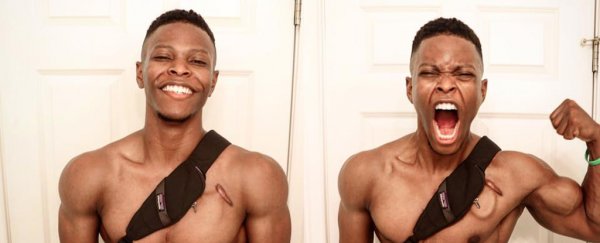If you want to know just how far medical technology has come, take a look at Andrew Jones. The fitness model and bodybuilder from Connecticut lives an active life that would put most of us to shame, despite relying on an artificial heart pump and pacemaker that he carries in a backpack 24/7.
AJ lives with the scars of past operations and has to charge up his lifesaving equipment every night, but remains incredibly positive while waiting for a full heart transplant that would let him drop the backpack for good.
"I'm pretty much the best-looking zombie you'll ever see," he says, referring to the fact you won't find a pulse anywhere on his body.
Is it just me, or does watching AJ working out with the weight of an artificial heart system strapped to his back make all the usual excuses for missing the gym seem more than a little flimsy…
Just like 25-year-old Stan Larkin, who wore a similar backpack device for 555 days while waiting for his own transplant, Andrew relies on the equipment constantly wired to his body to keep everything in check.
The device he's using is a Left Ventricular Assist Device, or LVAD. It combines a battery pack and a computer that monitors blood flow and keeps the blood pumping around the body in a natural way.
Technically speaking, it's not a completely artificial heart like Stan Larkin's, who had his natural organ completely removed. Instead the device helps Andrew's existing heart do its job, and without the device, it would almost certainly fail.
That's because in 2012, the fitness fanatic was diagnosed with cardiomyopathy - a disease of the heart that can lead to irregular heart rate, shortness of breath, and sudden cardiac arrest. After four months in intensive care, he received his LVAD.
Andrew doesn't hide his device or his scars (as you can tell from his Instagram feed), but it's not designed to be a permanent solution, just a temporary fix until a heart donor can be found. Andrew has even founded a new charity, Hearts at Large, to raise awareness of the issues around life-saving transplants.
According to the United Network for Organ Sharing, almost 120,000 people in the US are waiting for a life-saving organ transplant. One donor can save up to eight people, but 22 people die each day because a suitable donor can't be found in time.
Devices like Andrew's LVAD, and the one Stan had, called Syncardia, can keep patients alive while they wait for a transplant to happen, but finding a new heart is still the ultimate goal.
"This is my life for now," says Andrew. "Either I can dwell and feel sorry for myself, or I can continue doing the things that I love to do, the best way I can. And I haven't stopped."
It might be time to dig out your gym membership card again…
